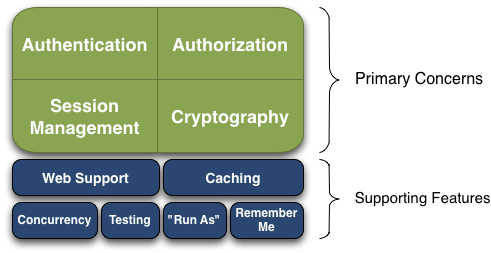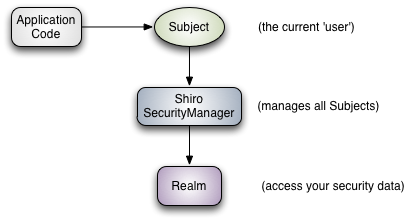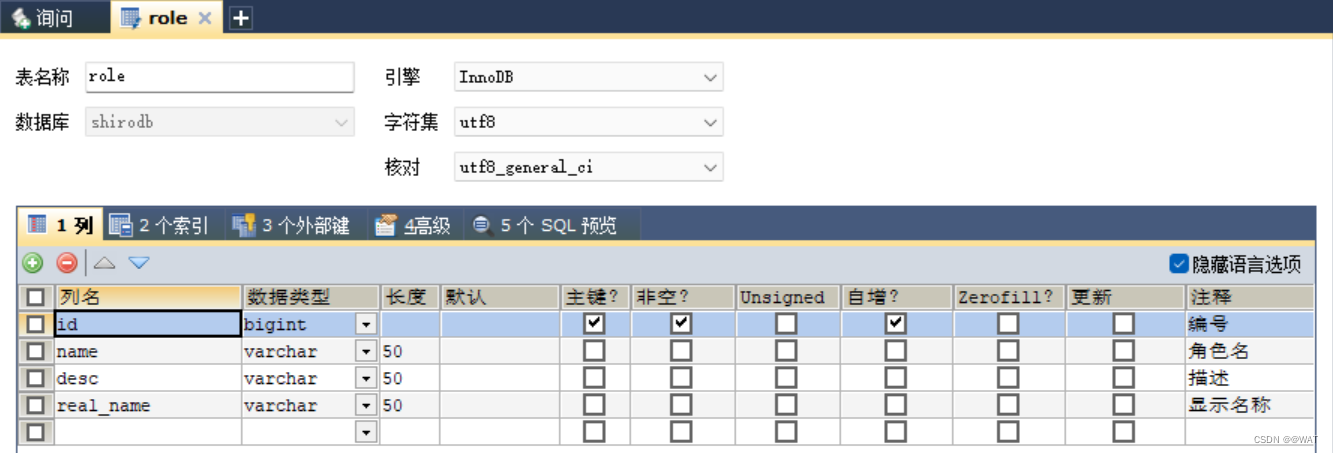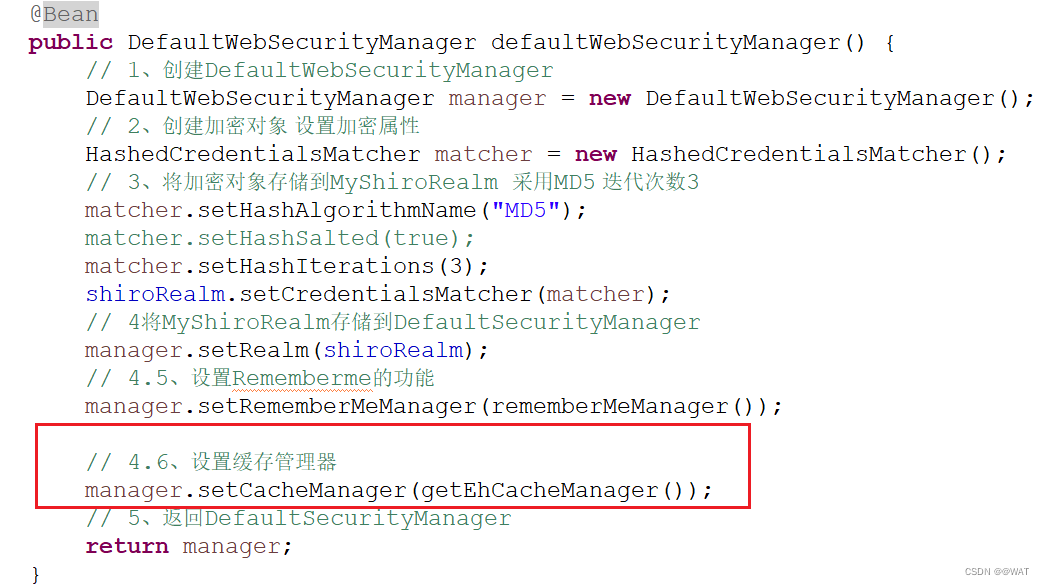文章目录
Shiro安全框架
一、 入门概述
1.1、Shiro是什么
Apache Shiro 是一款功能强大的且易于使用的Java的安全框架。Shiro可以完成:认证、加密、会话管理、与web集集成等。借助SHiro可以帮助我们快速轻松的保护任何应用程序。
shiro官网:Apache Shiro | Simple. Java. Security.

1.2、为什么使用Shiro
与Shiro的特性密不可分:
- 易于使用
- 全面
- 灵活
- 强力支持Web
- 兼容性强
- 社区支持
1.3、Shiro与Spring Security的区别
-
SpringSecurity基于Spring开发,项目若使用Spring 可以与SpringSecurity作权限更加方便,而Shiro需要与Spring进行整合
-
Spring Security功能更加丰富
-
Spring Security社区资源更加丰富
看到这里,是不是有些人就认为Spring Security功能更发面都比Shiro好,为什么不学习SpringSecurity。有一句话:
存在即合理。下面看看Shiro的特点
-
Shiro的配置和使用比较简单,SpringSecurity使用比较复杂
-
Shiro的依赖性低,不需要任何的容器与框架,可以独立运行
-
Shiro不仅仅可以使用在Web端,可以使用在任何的场景。
1.4、基本功能
了解Shiro的功能,我们可以去官网下载一张Shiro的功能结构图来进行补充学习:

1.4.1、主要功能
- 认证登录(Authentication)
- 授权验证(Authorization)
- 会话管理(Session Management)
- 密码加密(Cryptography)
1.4.2 、次要功能
- Web支持(web support)
- 缓存(caching)
- 多线程并发验证(Concurrency)
- 测试(Testing)
- 另外身份登录(Run as)
- 记住我(Remember me)
1.5、架构原理
从外部来看Shiro,即从应用程序的角度来观察使用Shiro完成工作

应用程序—>(登录)---->subject(对象)进行身份校验---->安全管理器(SecurityManager)---->Reaim(用户登陆的用户信息)
从内部的架构来看Shiro

二、基本使用
2.1、环境准备
1、Shiro不依赖容器,可以直接利用Maven使用
2、添加依赖
<!-- Shiro依赖 -->
<dependencies>
<dependency>
<groupId>org.apache.shiro</groupId>
<artifactId>shiro-core</artifactId>
<version>1.9.0</version>
</dependency>
<dependency>
<groupId>commons-logging</groupId>
<artifactId>commons-logging</artifactId>
<version>1.2</version>
</dependency>
</dependencies>
3、创建Maven工程
结构如下:

2.2、配置ini文件
在创建好的工程的Resources目录下,创建一个shiro.ini文件

[users]
zhangsan=z3
lisi=l4
2.3、登录认证
2.3.1、登录认证概念
(1)身份认证:一般需要提供身份ID等一些表示用户登陆这信息身份的标识,如提供email、用户名\密码来认证
(2)在Shiro中、用户需要提供principals(身份)和credentials(证明)给shiro。从而应用能验证用户身份。
2.3.2、登录认证的流程
- 收集用户二点身份/凭证,及如用户名/密码
- 调用Subject.login进行登录,如果失败则将得到的相应的AuthenticationException异常,根据异常提示用户登录错误信息,否则登陆成功。
- 创建自定义的Realm类,继承org.apache.shiro.realm.AuthenticationRealm类,实现doGetAuthenticationInfo()方法

2.3.3、登录认证示例
创建测试类,获取认证对象,进行登录认证,如下:
public class ShiroRun {
@SuppressWarnings("deprecation")
public static void main(String[] args) {
// 1、获取Shiro初始化 通过ini文件获取用户信息
@SuppressWarnings("deprecation")
IniSecurityManagerFactory factory = new IniSecurityManagerFactory("classpath:shiro.ini");
try {
// 通过工厂创建SecurityManager
SecurityManager securityManager = factory.getInstance();
SecurityUtils.setSecurityManager(securityManager);
// 2、获取Subject对象
Subject subject = SecurityUtils.getSubject();
// 3、获取外部参数 通过页面获取的用户名和密码 创建token对象
AuthenticationToken token = new UsernamePasswordToken("zhangsan", "z31");
// 4、完成登录
subject.login(token);
System.out.println("登陆成功...");
} catch (UnknownAccountException e) {
// TODO: handle exception
System.out.println("用户名不存在...");
} catch (IncorrectCredentialsException e) {
// TODO: handle exception
System.out.println("密码错误...");
} catch (AuthenticationException e) {
System.out.println("登陆失败...");
}
}
}
登陆成功:

密码错误:

账户错误:

2.4、角色、授权
2.4.1、授权
授权:也叫做访问控制,即在应用中控制谁访问哪些资源授权中需要了解的概念:主体(Subject)、资源(Resources)、权限(Permission)、角色(Role)
- **主体:**访问应用的用户,用户经授权才可访问指定资源
- **资源:**在应用中用户可以访问的URL,比如JSP页面,查看/编辑某些权限
- **权限:**表示在应用中用户能不能访问某个资源(有没有权利去访问某一个资源)
Shiro支持粗粒度的授权(用户模块的所有权限的授权)、也支持细粒度的授权(某个模块下的某个功能,比如查询)
2.4.1.1、授权方式
- 编程式授权:通过IF-ELSE授权
if(subject.hasRole("admin")){
// 有admin的权限
}else if(subject.hasRole("commons")){
// 普通用户的权限
}else{
// 没有权限
}
- 注解式:通过执行的Java方法上加上注解完成,没有泉下今年的将抛出异常
@RequriesRole("admin")
public void queryALL(){
// 具体的业务逻辑
}
- JSP/GSP标签,在JSP/GSP页面通过相应的标签完成
<shiro:hasRole name="admin">
<input type="button" class="queryAll" name="queryAll" value="查询所有"/>
</shiro:hasRole>
2.4.1.2、授权流程
- 首先调用
Subject.isPermitted*/hasRole*接口,其余委托SecurityManager。而SecurityManager接着会委托给Authorizer。 - Authorizer是真正的授权者,如果调用isPermitted(“user:view”),其首先会通过PermissionResolver把字符串转化成相应的Permission示例。
- 再授权之前,其会调用相应的Realm获取Subject相应的角色/权限用于匹配传入的角色/权限
- Authorizer会判断Realm的角色/权限是否与传过来的匹配,如果有多个Realm,则会委托给ModularRealmAuthorizer进行循环判断,如果匹配如
isPermitted*/hasRole*会返回true,否则返回false表示授权失败。
- Authorizer会判断Realm的角色/权限是否与传过来的匹配,如果有多个Realm,则会委托给ModularRealmAuthorizer进行循环判断,如果匹配如

2.4.2、角色
角色:权限的集合(比如说系统管理员、业务人员、普通用户人员等)
2.4.3、角色授权示例
【角色】
在ini文件里配置用户角色的权限信息:
[users]
zhangsan=z3,admin,commons
lisi=l4,commons
[roles]
admin=user:insert,user:select
commons=user:select
通过以下方式完成用户角色下权限的判断:
if (subject.isPermitted("user:insert")) {
System.out.println("用户有插入权限");
}else {
System.out.println("没有insert权限");
}
完整示例:
public class ShiroRun {
@SuppressWarnings("deprecation")
public static void main(String[] args) {
// 1、获取Shiro初始化 通过ini文件获取用户信息
@SuppressWarnings("deprecation")
IniSecurityManagerFactory factory = new IniSecurityManagerFactory("classpath:shiro.ini");
try {
// 通过工厂创建SecurityManager
SecurityManager securityManager = factory.getInstance();
SecurityUtils.setSecurityManager(securityManager);
// 2、获取Subject对象
Subject subject = SecurityUtils.getSubject();
// 3、获取外部参数 通过页面获取的用户名和密码 创建token对象
AuthenticationToken token = new UsernamePasswordToken("lisi", "l4");
// 4、完成登录
subject.login(token);
System.out.println("登陆成功...");
// 5、判断用户角色
if(subject.hasRole("commons")) {
System.out.println("拥有commons角色");
}else{
System.out.println("没有拥有commons角色");
}
if (subject.isPermitted("user:insert")) {
System.out.println("用户有插入权限");
}else {
System.out.println("没有insert权限");
}
} catch (UnknownAccountException e) {
// TODO: handle exception
System.out.println("用户名不存在...");
} catch (IncorrectCredentialsException e) {
// TODO: handle exception
System.out.println("密码错误...");
} catch (AuthenticationException e) {
System.out.println("登陆失败...");
}
}
}
注意:使用subject.checkPermission(“user:insert”);没有权限则会抛异常
【授权】
首先现在ini文件里为用户添加相应的角色(zhangsan添加admin、commons角色;lisi添加commons角色)
[users]
zhangsan=z3,admin,commons
lisi=l4,commons
使用以下方式判断角色:
if(subject.hasRole("commons")) {
System.out.println("拥有commons角色");
}else{
System.out.println("没有拥有commons角色");
}
完整示例:
public class ShiroRun {
@SuppressWarnings("deprecation")
public static void main(String[] args) {
// 1、获取Shiro初始化 通过ini文件获取用户信息
@SuppressWarnings("deprecation")
IniSecurityManagerFactory factory = new IniSecurityManagerFactory("classpath:shiro.ini");
try {
// 通过工厂创建SecurityManager
SecurityManager securityManager = factory.getInstance();
SecurityUtils.setSecurityManager(securityManager);
// 2、获取Subject对象
Subject subject = SecurityUtils.getSubject();
// 3、获取外部参数 通过页面获取的用户名和密码 创建token对象
AuthenticationToken token = new UsernamePasswordToken("zhangsan", "z3");
// 4、完成登录
subject.login(token);
System.out.println("登陆成功...");
// 5、判断用户角色
if(subject.hasRole("commons")) {
System.out.println("拥有commons角色");
}else{
System.out.println("没有拥有commons角色");
}
} catch (UnknownAccountException e) {
// TODO: handle exception
System.out.println("用户名不存在...");
} catch (IncorrectCredentialsException e) {
// TODO: handle exception
System.out.println("密码错误...");
} catch (AuthenticationException e) {
System.out.println("登陆失败...");
}
}
}
2.5、密码加密
在实际的开发中,一些敏感的信息需要加密,比如说用户的密码,shiro内嵌了很多的加密算法
2.5.1、使用Shiro进行加密
public class ShiroMD5 {
public static void main(String[] args) {
String salt = "salt";
// 1、密码明文
String password = "z3";
// 2、使用MD5加密
Md5Hash MD5 = new Md5Hash(password);
System.out.println("使用MD5加密后的密码:" + MD5.toHex());
// 3、给MD5加盐值 在加密玩的再次拼接一段字符串
Md5Hash MD5_2 = new Md5Hash(password, salt);
System.out.println("使用MD5(带盐值)加密后的密码:" + MD5_2.toHex());
// 3、给MD5加盐值 多次加密
Md5Hash MD5_3 = new Md5Hash(password, salt,3);
System.out.println("使用MD5(带盐值三次加密)加密后的密码:" + MD5_3.toHex());
}
}

三、Shiro整合SpringBoot
3.1、整合依赖
<project xmlns="http://maven.apache.org/POM/4.0.0"
xmlns:xsi="http://www.w3.org/2001/XMLSchema-instance"
xsi:schemaLocation="http://maven.apache.org/POM/4.0.0 http://maven.apache.org/xsd/maven-4.0.0.xsd">
<modelVersion>4.0.0</modelVersion>
<parent>
<groupId>com.wei</groupId>
<artifactId>dhcc_ShiroProject</artifactId>
<version>0.0.1-SNAPSHOT</version>
</parent>
<artifactId>dhcc_ShiroSpringBoot</artifactId>
<properties>
<java.version>1.8</java.version>
<spring.shiro.version>1.9.0</spring.shiro.version>
</properties>
<dependencies>
<dependency>
<groupId>org.springframework.boot</groupId>
<artifactId>spring-boot-starter-web</artifactId>
</dependency>
<dependency>
<groupId>org.springframework.boot</groupId>
<artifactId>spring-boot-starter-test</artifactId>
<scope>test</scope>
</dependency>
<!-- shiro -->
<dependency>
<groupId>org.apache.shiro</groupId>
<artifactId>shiro-spring-boot-web-starter</artifactId>
<version>${spring.shiro.version}</version>
</dependency>
<dependency>
<groupId>org.projectlombok</groupId>
<artifactId>lombok</artifactId>
<optional>true</optional>
</dependency>
<!--页面模板依赖-->
<dependency>
<groupId>org.springframework.boot</groupId>
<artifactId>spring-boot-starter-thymeleaf</artifactId>
</dependency>
<!--热部署依赖-->
<dependency>
<groupId>org.springframework.boot</groupId>
<artifactId>spring-boot-devtools</artifactId>
<scope>runtime</scope>
</dependency>
<!-- MyBatis-plus -->
<dependency>
<groupId>com.baomidou</groupId>
<artifactId>mybatis-plus-boot-starter</artifactId>
<version>3.0.5</version>
</dependency>
<!-- MySQL -->
<dependency>
<groupId>mysql</groupId>
<artifactId>mysql-connector-java</artifactId>
<version>8.0.28</version>
</dependency>
</dependencies>
<build>
<plugins>
<plugin>
<groupId>org.springframework.boot</groupId>
<artifactId>spring-boot-maven-plugin</artifactId>
</plugin>
</plugins>
</build>
</project>
3.2、yml配置文件
mybatis-plus:
configuration:
log-impl: org.apache.ibatis.logging.stdout.StdOutImpl
mapper-locations: classpath:mapper/*Mapper.xml
spring:
datasource:
type: com.zaxxer.hikari.HikariDataSource
driver-class-name: com.mysql.cj.jdbc.Driver
url: jdbc:mysql://localhost:3306/shirodb?characterEncoding=UTF-8&useUnicode=true&useSSL=false&serverTimezone=UTC
username: root
password: 123456
jackson:
date-format: yyyy-MM-dd HH:mm:ss
time-zone: GMT+8
shiro:
loginUrl: /shiroController/login
3.3、创建目录结构

3.4、创建数据库
打开SqlYog工具创建数据库shirodb
USE `shirodb`;
DROP TABLE IF EXISTS `user`;
CREATE TABLE `user` (
`id` bigint NOT NULL AUTO_INCREMENT COMMENT '主键id',
`name` varchar(50) DEFAULT NULL COMMENT '用户名',
`password` varchar(50) DEFAULT NULL COMMENT '密码',
`role_id` bigint DEFAULT NULL COMMENT '角色编号',
PRIMARY KEY (`id`)
) ENGINE=InnoDB DEFAULT CHARSET=utf8mb3;
3.5、创建对应的类
【实体类User】
@Data
public class User {
private Long id;
private String name;
private String password;
private Long roleId;
}
【respority数据持久层】
@Repository
public interface UserMapper extends BaseMapper<User>{}
采用MyBatis-PLUS的通用Mapper
【Service数据服务层(业务层)】
// 接口
public interface UserService {
User getUserInfoByName(String name);
}
// 实现类
@Service
public class UserServiceImpl implements UserService {
@Resource
private UserMapper userMapper;
public User getUserInfoByName(String name) {
QueryWrapper<User> queryWrapper = new QueryWrapper<User>();
queryWrapper.eq("name", name);
User user = userMapper.selectOne(queryWrapper);
return user;
}
}
【controller控制层】
@Controller
@RequestMapping("/shiro")
public class UserController {
@RequestMapping(value = "/login", method = RequestMethod.GET)
@ResponseBody
public String login(@RequestParam("name") String name, @RequestParam("password") String password) {
// 1、获取Subject对象
Subject subject = SecurityUtils.getSubject();
// 2、 封装请求对象到Token对象
UsernamePasswordToken token = new UsernamePasswordToken(name,password);
try {
// 3、调用Subject的login方法完成登录
subject.login(token);
return "登陆成功!";
} catch (UnknownAccountException e) {
e.printStackTrace();
System.out.println("用户名不存在...");
return "用户名错误,登陆失败";
} catch (IncorrectCredentialsException e) {
e.printStackTrace();
System.out.println("密码错误...");
return "密码错误,登陆失败!";
} catch (AuthenticationException e) {
e.printStackTrace();
System.out.println("登陆失败...");
return "登陆失败";
}
}
}
【Shiro的自定义授权配置类】
@Component
public class MyShiroRealm extends AuthorizingRealm {
@Resource
private UserService UserService;
/**
* 用户的登录信息 自定义授权方法
*/
@Override
protected AuthorizationInfo doGetAuthorizationInfo(PrincipalCollection principals) {
// TODO Auto-generated method stub
return null;
}
/**
* 自定义登录认证方法 token
*/
@Override
protected AuthenticationInfo doGetAuthenticationInfo(AuthenticationToken token) throws AuthenticationException {
// 获取登录用户的信息
String name = token.getPrincipal().toString(); // 获取用户名
// String password = new String((char[]) token.getCredentials()); // 获取密码
// 调用业务层的接口获取数据库的用户信息
User user = UserService.getUserInfoByName(name);
if (user != null) {
// 封装数据
AuthenticationInfo info = new SimpleAuthenticationInfo(
token.getPrincipal().toString(),
user.getPassword(),
ByteSource.Util.bytes("salt"),
token.getPrincipal().toString()
);
return info;
}
return null;
}
}
这里需要继承一下AuthorizingRealm,重写参数为token的方法,实现用户的授权登录功能
3.6、创建Shiro配置类
3.6.1、自定义Shiro配置类
要想实现自定义的Shiro配置类,需要创建一个DefaultSecurityManager的方法,在里面去重新自定义授权功能。
@Configuration
public class ShiroConfig {
@Resource
private MyShiroRealm shiroRealm;
/**
* 描述:TODO(这里用一句话描述这个方法的作用)
* @Title: 创建默认的安全管理器
* @return
* @author weiyongpeng
* @date 2022年10月3日 上午8:15:52
*/
@Bean
public DefaultWebSecurityManager defaultWebSecurityManager() {
// 1、创建DefaultWebSecurityManager
DefaultWebSecurityManager manager = new DefaultWebSecurityManager();
// 2、创建加密对象 设置加密属性
HashedCredentialsMatcher matcher = new HashedCredentialsMatcher();
// 3、将加密对象存储到MyShiroRealm 采用MD5 迭代次数3
matcher.setHashAlgorithmName("MD5");
matcher.setHashIterations(3);
shiroRealm.setCredentialsMatcher(matcher);
// 4将MyShiroRealm存储到DefaultSecurityManager
manager.setRealm(shiroRealm);
// 5、返回DefaultSecurityManager
return manager;
}
}
3.6.2、自定义Shiro拦截范围
@Bean
public DefaultShiroFilterChainDefinition shiroFilterChainDefinition() {
DefaultShiroFilterChainDefinition filter = new DefaultShiroFilterChainDefinition();
// 设置不忍证可以访问的资源
filter.addPathDefinition("/shiro/login", "anon");
filter.addPathDefinition("/login","anon");
// 设置需要进行登录才可以访问的拦截范围
filter.addPathDefinition("/**", "authc");
return filter;
}
3.7、测试
使用APIFOX测试登录
【登陆成功】

【登陆失败】

3.8、登录认证前端
使用Thymeleaf实现前端的登陆页面
【引入依赖】
<!--页面模板依赖-->
<dependency>
<groupId>org.springframework.boot</groupId>
<artifactId>spring-boot-starter-thymeleaf</artifactId>
</dependency>
【添加配置】
thymeleaf:
cache: false
prefix: classpath:/templates/
suffix: .html
encoding: UTF-8
mode: HTML5
【编写页面】
登陆页面
<!DOCTYPE html>
<html lang="en" xmlns:th="http://www.thymeleaf.org">
<head>
<meta charset="UTF-8">
<title>登录</title>
</head>
<body>
<h1>Shiro登录认证</h1>
<form th:action="@{/shiro/userLogin}" method="post">
<div>
<label>用户名:</label> <input type="text" name="name"
placeholder="请输入用户名:">
</div>
<div>
<label>用户名:</label> <input type="password" name="password"
placeholder="123456">
</div>
<div class="buttonDiv">
<input type="reset" value="重置">
<input type="submit" value="登录">
</div>
</form>
</body>
</html>
登陆成功首页
<!DOCTYPE html>
<html lang="en" xmlns:th="http://www.thymeleaf.org">
<head>
<meta charset="UTF-8">
<title>登录首页</title>
</head>
<body>
登陆的用户:<span th:text="${session.user}"></span>
</body>
</html>
登陆失败错误页
<!DOCTYPE html>
<html>
<head>
<meta charset="UTF-8">
<title>Insert title here</title>
</head>
<body>
<h1>登陆失败错误页面</h1>
<h3>
对不起,你在登陆的时候遇到了<span th:text="${errorMsg}"></span>的错误
<a th:href="@{/shiro/login}">重新登陆</a>
</h3>
</body>
</html>
修改controller的代码
@RequestMapping(value = "/login",method = RequestMethod.GET)
public String login() {
return "login";
}
@RequestMapping(value = "/userLogin", method = RequestMethod.POST)
public String userLogin(@RequestParam("name") String name,
@RequestParam("password") String password,
HttpSession session,
Model model) {
// 1、获取Subject对象
Subject subject = SecurityUtils.getSubject();
// 2、 封装请求对象到Token对象
UsernamePasswordToken token = new UsernamePasswordToken(name,password);
try {
// 3、调用Subject的login方法完成登录
subject.login(token);
// 放入session
session.setAttribute("user", token.getPrincipal().toString());
return "main";
} catch (UnknownAccountException e) {
e.printStackTrace();
System.out.println("用户名不存在...");
model.addAttribute("errorMsg","用户名错误,登陆失败");
return "error";
} catch (IncorrectCredentialsException e) {
e.printStackTrace();
System.out.println("密码错误...");
model.addAttribute("errorMsg","密码错误,登陆失败!");
return "error";
} catch (AuthenticationException e) {
e.printStackTrace();
System.out.println("登陆失败...");
model.addAttribute("errorMsg","登陆异常,登陆失败!");
return "error";
}
}
四、多个Realm登录校验
- 多个Realm实现原理
当应用程序配置多个Realm时,例如,用户名密码校验,手机号校验,邮箱校验等等。Shiro的ModularRealmAuthentication会使用内部的AuthenticationStarategy组件判断认证是否成功或者谁败。
AuthenticationStrategy是一个无状态的组件,它本身验证尝试中被询问4次(这4次交互所需的任何必须的状态将被作为方法参数)
(1)在所有的Realm被调用之前
(2)在调用Realm的getAuthenticationInfo()方法之前
(3)在调用Realm的getAuthenticationInfo()方法之后
(4)在所有的Realm被调用之后
五、rememberMe功能
Shiro提供了记住我的(Remember Me)功能,用户可以在登陆成功后,下次访问页面无需再次登录仍然可以访问。
5.1、基本流程
- 首先在登陆的页面选中Remember Me然后再登陆成功后,如果是浏览器登录,一般会把Remember Me的Cookie写道客户端并保存。
- 关闭浏览器再次重新打开,会发现浏览器还是记住你。
- 访问一般的网页服务器,仍然知道你是谁,且能正常访问。
- 但是,如果我们访问电商平台,如果要查看我的订单或者进行支付,此事还需再次进行身份的认证。
5.2、代码实现
5.2.1、设置记住我
在配置类里的安全管理器方法里添加记住我功能

5.2.2、配置记住我管理器以及Cookie属性
// Cookie的属性设置
public SimpleCookie rememberCookie() {
SimpleCookie cookie = new SimpleCookie("rememberMe");
// 设置跨域
// cookie.setDomain(domain);
cookie.setPath("/");
cookie.setHttpOnly(true);
cookie.setMaxAge(30*24*60*60); // 30天
return cookie;
}
//创建CookieMaanger
public CookieRememberMeManager rememberMeManager() {
CookieRememberMeManager manager =new CookieRememberMeManager();
manager.setCookie(rememberCookie());
manager.setCipherKey("1234567890987654".getBytes());
return manager;
}
5.2.3、添加用户过滤器
保证在登陆成功后,Shiro将登陆成功的用户信息放入到cookie中存储

5.2.4、改造Controller登录接口
// 2、 封装请求对象到Token对象 开启Remember
UsernamePasswordToken token = new UsernamePasswordToken(name,password,rememberMe);
5.2.5、改造登陆页面
<div>记住我:<input type="checkbox" name="rememberMe" value="true"> </div>

六、用户登出
用户登陆之后,配套的操作有登出操作,直接通过Shiro过滤器即可以实现
6.1、代码实现
【过滤器】
@Bean
public DefaultShiroFilterChainDefinition shiroFilterChainDefinition() {
DefaultShiroFilterChainDefinition filter = new DefaultShiroFilterChainDefinition();
// 设置不认证可以访问的资源
filter.addPathDefinition("/shiro/userLogin", "anon");
filter.addPathDefinition("/shiro/login","anon");
// 配置登出操作
filter.addPathDefinition("/logout", "logout");
// 设置需要进行登录认证才可以访问的拦截范围
filter.addPathDefinition("/**", "authc");
// 添加remember的用户
filter.addPathDefinition("/**", "user");
return filter;
}
【登陆后的页面改造】

七、授权、角色认证
7.1、角色认证
用户登录后,需要验证是否具有指定角色权限,Shiro也提供了方便的工具进行判断,
这个工具就是Realm的doGetAuthenticationinfo方法进行判断,出发权限判断的有两种方式
- 在页面中通过shiro:xxxx属性判断
- 在接口中通过注解@Requiresxxxxx判断
7.1.1、后端接口服务注解🔥🔥🔥
同过给接口方法添加注解可以实现权限校验,可以加载控制器上,也可以加载业务方法上,一般加载控制器方法上,常用的注解如下:
- @RequiresAuthentication
验证用户是否登录,等同于方法subject.isAuthenticated();
- @RequiresUser
验证用户是否记忆:
登录认证成功subject.isAuthenticated()为true
登录后被记忆subjec.isRemembered()为true
- @RequiresGuest
验证是否是一个Guest请求,是否是游客的请求
此时subject.getPrincipal()为null
- @RequiresRoles
验证subject是否有相应的角色,有角色访问方法,否则会抛出异常
AuthentizationException
例如:@RequiresRoles(“aRoleName”)
void someMethod();
只有subject有aRoleName角色才能访问方法someMethod()
- @RequiresPremissions🔥🔥
验证subject是否具有相应的权限,有权限访问方法,没有则抛出异常
AuthorizationException。
例如:@RequiresPermissions(“USER_SERVICE:QUERY”,“USER_SERVICE:MODIFY”);
void someMethod();
subject只有同时具有USER_SERVICE:QUERY,USER_SERVICE:MODIFY权限才可以访问someMethod()方法
7.1.2、授权验证-没有角色无法访问
【首先在Controller层写一个方法】
@RequiresRoles("admin")
@RequestMapping(value = "/userLoginRoles",method = RequestMethod.GET)
@ResponseBody
public String userLoginRoles() {
System.out.println("登陆验证表示");
return "验证角色成功";
}
注意加上注解@RequiresRoles
当我们去访问这个接口的时候,如果这时候还有没做任何的操作,肯定会被抛出异常,如下图所示:

7.1.3、授权验证-有角色
在自定义的Realm类里重写的doGetAuthorizationInfo定义角色授权信息
@Override
protected AuthorizationInfo doGetAuthorizationInfo(PrincipalCollection principals) {
// 进行授权信息
System.out.println("进入自定义授权方法");
// 有权限放行
// 1、 创建存储信息的对象
SimpleAuthorizationInfo info = new SimpleAuthorizationInfo();
// 2、存储角色信息 正常是从数据库里获取
info.addRole("admin");
// 3、返回角色信息
return info;
}

7.1.4、创建角色表
在实际的业务开发中,我们要想完成角色的认证授权,不能向上述一样,需要在数据库中获取相关的用户权限角色信息。
【权限表】

【创建权限实体类】
public class Role {
/**
* 权限编号
*/
private Long id;
/**
* 角色名称
*/
private String name;
/**
* 描述
*/
private String desc;
/**
* 显示名称
*/
private String realName;
}
【用户角色表】

【mapper的查询用户角色】
@Select("SELECT NAME FROM role r WHERE r.`id` IN (\r\n" +
" SELECT ru.`role_id` FROM role_user ru WHERE ru.`user_id`=(\r\n" +
" SELECT u.`role_id` FROM `user` u WHERE u.`name` = #{principal} \r\n" +
" )\r\n" +
")")
List<String> getUserRolesInfoMapper(@Param("principal") String principal);
【Service接口方法】
List<String> getUserRolesInfo(String name);
【自定义MyShiroRealm】
@Resource
private UserService UserService;
/**
* 用户的登录信息 自定义授权方法
*/
@Override
protected AuthorizationInfo doGetAuthorizationInfo(PrincipalCollection principals) {
// 进行授权信息
System.out.println("进入自定义授权方法");
// 有权限放行
// 1、 创建存储信息的对象
SimpleAuthorizationInfo info = new SimpleAuthorizationInfo();
// 2、存储角色信息 正常是从数据库里获取
// info.addRole("admin");
List<String> rolesInfo = UserService.getUserRolesInfo(principals.getPrimaryPrincipal().toString());
rolesInfo.forEach(System.out::println);
info.addRoles(rolesInfo);
// 3、返回角色信息
return info;
}
7.2、授权访问
获取权限进行验证,首先是创建权限资源表
CREATE TABLE `shirodb`.`premissions`(
`id` BIGINT(20) NOT NULL AUTO_INCREMENT COMMENT '编号',
`name` VARCHAR(50) COMMENT '权限名称',
`info` VARCHAR(30) COMMENT '权限信息',
`desc` VARCHAR(50) COMMENT '描述',
PRIMARY KEY (`id`)
) ENGINE=INNODB CHARSET=utf8 COLLATE=utf8_general_ci;
同理角色认证的编写,首先要在添加相应的接口方法查询数据库中对应角色下的权限集合。
【mapper】
@Select({
"<script>",
"select info from premissions where id in ",
"(select permissions_id from role_ps where role_id in (",
"select id from role where name in ",
"<foreach collection='roles' item='name' open='(' separator=',' close=')'>",
"#{name}",
"</foreach>",
"))",
"</script>"
})
List<String> getUserPermissionsInfoMapper(@Param("roles") List<String> roles);
【Service接口】
List<String> getUserPermisssionsInfo(List<String> roles);
【Controller接口】
@RequiresPermissions(value = {"user:update","user:delete","user:add"})
@RequestMapping(value = "/userLoginPermissions",method = RequestMethod.GET)
@ResponseBody
public String userLoginPermissions() {
System.out.println("登陆权限验证标识");
return "验证权限成功";
}
注意🔥@RequiresPermissions注解的参数value是一个数组
最后要想真正能够的实现功能,还需要再自定义的Realm类里定义权限认证。
@Override
protected AuthorizationInfo doGetAuthorizationInfo(PrincipalCollection principals) {
// 进行授权信息
System.out.println("进入自定义授权方法");
// 有权限放行
// 1、 创建存储信息的对象
SimpleAuthorizationInfo info = new SimpleAuthorizationInfo();
// 2、存储角色信息 正常是从数据库里获取
// info.addRole("admin");
// 3、获取用户角色信息
List<String> rolesInfo = UserService.getUserRolesInfo(principals.getPrimaryPrincipal().toString());
// 3、获取用户的权限信息
List<String> permisssionsInfo = UserService.getUserPermisssionsInfo(rolesInfo);
permisssionsInfo.forEach(System.out::println);
rolesInfo.forEach(System.out::println);
// 4、存储到info、对象中
info.addStringPermissions(permisssionsInfo); // 权限信息
info.addRoles(rolesInfo); // 角色信息
// 5、返回角色信息
return info;
}
八、自定义异常
创建认证异常处理类,使用@ControllerAdvice加@ExceptionHandler注解实现特殊异常处理
@ControllerAdvice
public class PermissionsException {
/**
* 描述:没有权限自定义异常
* @Title: doNoPermissionException
* @return
* @author weiyongpeng
* @date 2022年10月4日 上午8:21:39
*/
@ResponseBody
@ExceptionHandler(UnauthorizedException.class)
public String doNoPermissionException(Exception e) {
return "对不起,您无权限访问";
}
/**
* 描述:无身份认证异常
* @Title: doNoAuthenticationException
* @param e
* @return
* @author weiyongpeng
* @date 2022年10月4日 上午8:23:26
*/
@ResponseBody
@ExceptionHandler(AuthenticationException.class)
public String doNoAuthenticationException(Exception e) {
return "对不起,权限认证失败";
}
}
九、前端角色权限认证
前面虽然说已经实现了基本的功能,但是在用户体验上效果不是很好,我们在平常的系统中,比如说银行的管理系统、绩效系统。行内人员有着不同的权限,比如说行长有全权限,经理有调动查看账务的权限。我们想要的效果是:不同权限的用户登录系统后,看到的界面根据所拥有的权限显示。
那么接下来,我们来实现一把:
9.1、引入依赖
因为我们使用的前端框架是Thymeleaf,所以:
<!-- 配置Thyemleaf与Shiro的整合依赖 -->
<dependency>
<groupId>com.github.theborakompanioni</groupId>
<artifactId>thymeleaf-extras-shiro</artifactId>
<version>2.0.0</version>
</dependency>
配置Shiro的标签配置
// 配置类里配置解析Shiro标签的配置方法
@Bean
public ShiroDialect shiroDialect() {
return new ShiroDialect();
}
在Thymeleaf中常用的Shiro标签属性:
shiro:
引入完成后,直接启动应用会报错,因为thymeleaf-extras-shiro这个组件需要thymeleaf3.0支持,所以这里不再演示。
十、实现缓存
10.1、缓存工具Ehcache
Ehchche是一种广泛使用的开源Java分布式缓存框架,住哟啊面向的是通用缓存,JavaEE是轻量级的缓存容器。可以和大部分的Java项目无缝融合。例如Hibernate中使用的缓存技术就是Ehcache
Ehcache支持磁盘和内存中的存储,如果内存不够,可以放到磁盘中,也可以直接在JVM虚拟机中做缓存,高效,速度快,但是共享麻烦,分布式集群中不方便,主要做的是本地缓存。
10.2、Shiro整合Ehcache
Shiro官网提供了Shiro-ehcache的整合方案,减少对数据库的访问,提高项目的执行效率。
【添加依赖】
<!-- Shiro整合Ehcache框架 -->
<dependency>
<groupId>org.apache.shiro</groupId>
<artifactId>shiro-ehcache</artifactId>
<version>1.4.2</version>
</dependency>
<dependency>
<groupId>commons-io</groupId>
<artifactId>commons-io</artifactId>
<version>2.6</version>
</dependency>
【配置类配置缓存管理器】
/**
* 描述:获取ehcache缓存管理器
* @Title: getEhcacheManager
* @return
* @author weiyongpeng
* @date 2022年10月4日 上午9:12:36
*/
@Bean
public EhCacheManager getEhCacheManager() {
EhCacheManager ehCacheManager = new EhCacheManager();
InputStream stream = null;
try {
stream = ResourceUtils.getInputStreamForPath("classpath:ehcache/shiro-ehcache.xml");
} catch (Exception e) {
// TODO: handle exception
e.printStackTrace();
}
CacheManager cacheManager = new CacheManager(stream);
ehCacheManager.setCacheManager(cacheManager);
return ehCacheManager;
}























 8862
8862











 被折叠的 条评论
为什么被折叠?
被折叠的 条评论
为什么被折叠?










